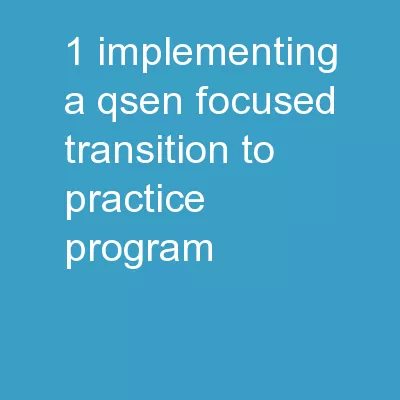

QSEN Conference May 31 2017 Chicago IL NCSBN s Miss i on Th e N a tional Counci l o f S t at e Boa r d s o f Nu r sin g NC S BN p r o vides ID: 719879
Download Presentation The PPT/PDF document "1 Implementing a QSEN Focused Transitio..." is the property of its rightful owner. Permission is granted to download and print the materials on this web site for personal, non-commercial use only, and to display it on your personal computer provided you do not modify the materials and that you retain all copyright notices contained in the materials. By downloading content from our website, you accept the terms of this agreement.
Slide1
1
Implementing a QSEN Focused Transition to Practice Program
QSEN Conference - May 31, 2017, Chicago, ILSlide2
NCSBN
’s Missi
on
Th
e National Council of State Boards of Nursing (NCSBN) provides education, service and research through collaborative leadership to promote evidence-based regulatory excellence for patient safety and public protection.Slide3
Background
2001 NCSBN Employer’s study: Fewer than 50% of employers report newly licensed nurses are “safe and effective” in their practice.
Replicated in 2003 with similar results.
NCSBN BODs convened a TTP Committee, charged to design an evidence-based TTP modelSlide4
Background
Reviewed the evidence for a year (2009-2010)Literature reviewGaps in education/practice
Berkow
(2008)
Benner (2004)Patient safetyStress linked to errors (Elfering, 2007)Discipline reports (MA BON, 2007; Chicago Tribune, 2000)Missed care (Kalisch, 2006)Slide5
Background
Patient safety (cont’d)Ebright, 2004 (near misses)
Del Bueno, 2005 (COPA model)
Competence
Bjork & Kirkvold, 1999Dartmouth Hitchcock transition program, 2007Slide6
Background
RetentionKovner, 2009
– 26% in two years
Before economic downturn: 35%-60%What’s next? (Auerbach et al., 2011)Slide7
Reviewed Successful Programs
(2009-2010)UHC/AACN’s Residency (now Vizient
/AACN)
Versant Residency Program
Wisconsin Residency ProgramMississippi Residency ProgramSlide8
Successful International Programs
(2009 – 2010)Flying Start - Scotland
Canada’s Preceptorship Program
Australia’s Risk Management Program for new nurses
Portugal’s regulatory transition programSlide9
Evidence-Based Model Competencies
Specialty content
Communication
Safety
Clinical reasoning5. Prioritizing/organizingEvidence-based practiceRole socializationDelegating/supervisingSlide10
Threads
To be integrated throughout:Feedback
ReflectionSlide11
Collaborative Model
More than 35 stakeholders made suggestions on the model, including AACN, NLN, NOADN, ANA, AONE, HRSA, AHRQ, CMS, QSEN, etc.
QSEN suggested
crosswalking
with their competencies with goal of consistent national model.Slide12
QSEN Re-Categorizing
Specialty contentCommunication
Safety
Clinical reasoning
Patient Centered CareCommunication & TeamworkThreaded throughoutThreaded throughoutSlide13
Re-Categorizing
Prioritizing/organizingEvidence based practice
Role socialization
Delegating/supervising
Patient Centered CareEvidence Based PracticeCommunication & TeamworkCommunication & TeamworkSlide14
Four Consistent Threads
Safety
Clinical Reasoning
Feedback ReflectionSlide15
15Slide16
Multisite, Randomized, Controlled
Study (JNR, 2015)How effective is NCSBN’s TTP program in terms of safety, competence, stress, satisfaction and retention when compared to control group?
A Post Hoc Question Arose:
2. Do transition programs make a difference in new graduate outcomes in terms of safety, competence, stress, job satisfaction and retention?
16Slide17
Procedure
State and site coordinators for study integrity
Online modules and surveys in integrated website
All sites either went through their own IRB or Western IRB
All preceptors trained before the studySlide18
Outcome Measures
Baseline, 6, 9, and 12 months; all established for validity and reliability:Overall Competency (preceptors and nurses)
Specific Competencies (preceptors and nurses)
Safety Practices (nurses)Slide19
Outcome Measures (Cont’d)
Work Stress (nurses)
Job Satisfaction (nurses)
Preceptor Evaluation (preceptors and nurses)
Retention (data directly from the employers)Slide20
Results
No clear differences – so post-hoc question was asked: Do Transition to Practice Programs make a difference in new graduate outcomes in terms of safety, competence, stress, satisfaction and retention?
20Slide21
Results: Evidence-Based Components
Patient-centered careCommunication and teamwork
Evidence-based
practice
InformaticsSafetyClinical reasoningFeedbackReflectionPreceptorshipSpecialty content21Slide22
Results: Categories
TTP Program – n=43 (577 new nurses)Established Program – employ 6 components n=29 (300 new nurses)
Limited Program – employ fewer than 6 components – n=22 (186 new nurses)
22Slide23
Results Summarized
Established programs significantly increased:Overall competency
Job satisfaction
Established programs significantly decreased:
Work stressReports of errorsUse of negative safety practices (did not use universal precautions)TTP in middle; Limited on bottomSlide24
TTP vs. Established vs. LimitedTurnover
P <.001
24
Transition Program
New Nurses LeavingTTP14.7%Established Programs12.0%Limited Programs24.8%Slide25
QSEN Competencies
All three groups significantly improved over the yearlong period
Implication: QSEN is being consistently integrated into the academic curriculumSlide26
TTP Courses
Based on TTP study results:Communication and
Teamwork
Patient and Family-Centered CareEvidence Based PracticeQuality ImprovementInformaticsPreceptor TrainingSlide27
Key Features
Assess – Begin courses with branching scenarioLearn – Information on a wide variety of topics is presentedSustain – Real-world scenarios shared for applicationSlide28
Key Features (Cont’d)
Interact – Preceptor and peer discussions
Evaluate – Preceptor feedback at every step
Modalities – Scenarios, quizzes, videos, critical thinking activities, discussion opportunities with preceptors and peers
Branching Scenarios – Beginning of each courseSlide29Slide30Slide31Slide32Slide33
Slide34Slide35Slide36Slide37
“ The synergy inspired by the Quality and Safety Education for Nursing (QSEN) project over the past decade is leading the transformation of nursing education and practice to improve Quality and safety of health care.” ~ Sherwood & Barnsteiner, 2017
Contact Information:
Nancy Spector, PhD, RN, FAAN:
nspector@ncsbn.org